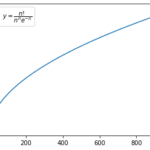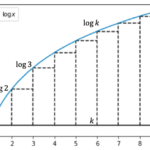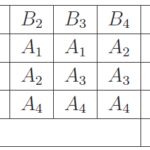イングランドの数学者ジョン・ウォリス(John Wallis)は次の公式
[math]
\dfrac{2\cdot 2}{1\cdot 3}\cdot
\dfrac{4\cdot 4}{3\cdot 5}\cdot
\dfrac{6\cdot 6}{5\cdot 7}\cdots = \dfrac{\pi}{2}
[/math]
を導きました。この公式は一見関係なさそうな
「偶数の積と奇数の積の比」と「円周率」がつながっている
ことを示していてて面白いですね。また、スターリングの公式、ガウス積分の導出する際に活躍する応用上も重要な公式です。
無限積が現れるため取り扱いが難しいように思えますが、ウォリス積分
[math]
\displaystyle I_n = \int_0^{\frac{\pi}{2}}\sin^n \theta d\theta
[/math]
の性質を使うことで高校数学の範囲で示すことができます。この記事では
- ウォリス積分の性質
- ウォリス公式の証明
と応用として二項係数[math]{}_{2n}C_n[/math]の漸近近似について紹介します。
ウォリス積分の性質
0以上の整数[math]n[/math]に対して
[math]
\displaystyle I_n = \int_0^{\frac{\pi}{2}}\sin^n \theta d\theta
[/math]
と定義します。この[math]I_n[/math]をウォリス積分と呼び以下の性質が知られています。
- [math]I_{n+1} \leq I_n[/math]
- [math]I_{n}=\dfrac{n-1}{n}I_{n-2}[/math]
- [math]I_{2n+1}=\dfrac{2n}{2n+1}\cdot \dfrac{2n-2}{2n-1}\cdots\dfrac{2}{3}\cdot 1[/math]
- [math]I_{2n}=\dfrac{2n-1}{2n}\cdot \dfrac{2n-3}{2n-2}\cdots\dfrac{1}{2}\cdot \dfrac{\pi}{2}[/math]
まず[math]0 \leq \theta \leq \frac{\pi}{2}[/math]で[math]0\leq \sin \theta \leq 1[/math]より[math]\sin^{n+1}\theta\leq \sin^{n}\theta[/math]なので[math]I_{n+1} \leq I_n[/math]となります。
次に部分積分することで
[math]
\begin{eqnarray}
I_n &=& \int_0^{\frac{\pi}{2}}\sin^n \theta d\theta \\
&=& \int_0^{\frac{\pi}{2}}(n-1)\cos^2\theta\sin^{n-2}\theta d\theta \\
&=& (n-1)\int_0^{\frac{\pi}{2}}(1-\sin^2\theta)\sin^{n-2}\theta d\theta \\
&=& (n-1)(I_{n-2}-I_n)
\end{eqnarray}
[/math]
が得られ、整理して
[math]
I_{n}=\dfrac{n-1}{n}I_{n-2}
[/math]
となります。この漸化式を繰り返し使い[math]I_0=\int_0^{\frac{\pi}{2}}\sin^0 \theta d\theta=\frac{\pi}{2}[/math], [math]I_1=\int_0^{\frac{\pi}{2}}\sin \theta d\theta=1[/math]に注意すると
[math]
\begin{eqnarray}
I_{2n+1} &=& \dfrac{2n}{2n+1}\cdot \dfrac{2n-2}{2n-1}\cdots\dfrac{2}{3}\cdot 1 \\
I_{2n} &=& \dfrac{2n-1}{2n}\cdot \dfrac{2n-3}{2n-2}\cdots\dfrac{1}{2}\cdot \dfrac{\pi}{2}
\end{eqnarray}
[/math]
が得られます。
ウォリスの公式の証明
ウォリスの公式の左辺の部分積を
[math]
W_n = \displaystyle\prod_{k=1}^n
\dfrac{2k\cdot 2k}{(2k-1)(2k+1)}
[/math]
とおくとウォリス積分[math]I_n[/math]を用いて
[math]
W_n = \dfrac{I_{2n+1}}{I_{2n}}\dfrac{\pi}{2}
[/math]
とかけます。ここで[math]I_{2n+1} \leq I_{2n}[/math]より[math]\dfrac{I_{2n+1}}{I_{2n}} \leq 1[/math]であり、さらに
[math]
\dfrac{I_{2n+1}}{I_{2n}} \geq \dfrac{I_{2n+2}}{I_{2n}} = \dfrac{2n+1}{2n+2}
[/math]
なので
[math]
\dfrac{2n+1}{2n+2} \leq
\dfrac{I_{2n+1}}{I_{2n}} \leq 1
[/math]
が成立します。挟み撃ちの原理より[math]n\to \infty[/math]の時[math]\dfrac{I_{2n+1}}{I_{2n}} \to 1[/math]となるので
[math]
\displaystyle\lim_{n\to\infty}W_n =
\lim_{n\to\infty}\dfrac{I_{2n+1}}{I_{2n}}\dfrac{\pi}{2}=\dfrac{\pi}{2}
[/math]
つまり
[math]
\displaystyle
\prod_{n=1}^\infty \dfrac{2n\cdot 2n}{(2n-1)(2n+1)} = \dfrac{\pi}{2}
[/math]
が成立します。
二項係数[math]{}_{2n}C_n[/math]の漸近近似
最後に応用例として二項係数[math]{}_{2n}C_n[/math]の漸近近似を求めます。この二項係数[math]{}_{2n}C_n[/math]は
- スターリングの公式(漸近近似)の証明
- エルデッシュによるベルトラン・チェビシェフの定理の証明
- カタラン数[math]C_n=\dfrac{{}_{2n}C_n}{n+1}[/math]
に現れ重要な役割を果たします。なお、スターリングの公式の証明は
で、ベルトラン・チェビシェフの定理は
で紹介しているので興味のある方はご参照ください。
まず一つ飛ばしの階乗(二重階乗といいます)を
[math]
n!! = n \cdot (n-2) \cdot (n-4) \cdots
[/math]
と表記することにします。この時
[math]
I_{2n} = \dfrac{(2n-1)!!}{(2n)!!}\cdot\dfrac{\pi}{2}
[/math]
と書けます。ここで
[math]
\begin{eqnarray}
(2n)!! &=& 2^n n! \\
(2n-1)!! &=& \dfrac{(2n)!}{(2n)!!} \\
&=& \dfrac{(2n)!}{2^nn!}
\end{eqnarray}
[/math]
なので、[math]{}_{2n}C_n=\dfrac{(2n)!}{n!n!}[/math]に注意すると
[math]
\begin{eqnarray}
I_{2n} &=& \dfrac{(2n-1)!!}{(2n)!!}\cdot\dfrac{\pi}{2} \\
&=& \dfrac{(2n)!}{2^nn!\cdot 2^n n!}\cdot\dfrac{\pi}{2} \\
&=& \dfrac{{}_{2n}C_n}{4^n}\cdot\dfrac{\pi}{2}
\end{eqnarray}
[/math]
となります。ここで次の補題を示します。
[math]
I_{n+1}I_n = \dfrac{\pi}{2(n+1)}
[/math]
漸化式[math]I_{n+1}=\dfrac{n}{n+1}I_{n-1}[/math]の両辺に[math](n+1)I_n[/math]をかけると[math](n+1)I_{n+1}I_n=nI_nI_{n-1}[/math]が成立します。これより
[math]
(n+1)I_{n+1}I_n=nI_nI_{n-1}=\cdots=I_1I_0=\dfrac{\pi}{2}
[/math]
となるので[math]I_{n+1}I_n = \dfrac{\pi}{2(n+1)}[/math]が成立します。
ここで[math]I_{2n+1} \leq I_{2n} \leq I_{2n-1}[/math]に[math]I_{2n}[/math]をかけると
[math]
\dfrac{\pi}{2(2n+1)} = I_{2n+1}I_{2n} \leq I_{2n}^2 \leq I_{2n}I_{2n-1}=\dfrac{\pi}{4n}
[/math]
が得られ
[math]
\sqrt{\dfrac{\pi}{2(2n+1)}} \leq I_{2n} = \dfrac{{}_{2n}C_n}{4^n}\cdot\dfrac{\pi}{2} \leq \sqrt{\dfrac{\pi}{4n}}
[/math]
を整理して
[math]
\dfrac{4^n}{\sqrt{\pi(n+\frac{1}{2})}} \leq {}_{2n}C_n \leq \dfrac{4^n}{\sqrt{\pi n}}
[/math]
を得ます。これより
[math]
\displaystyle\lim_{n\to\infty} \dfrac{{}_{2n}C_n}{\frac{4^n}{\sqrt{\pi n}}} = 1
[/math]
つまり十分大きな[math]n[/math]では[math]{}_{2n}C_n \sim \dfrac{4^n}{\sqrt{\pi n}}[/math]となることがわかります。




